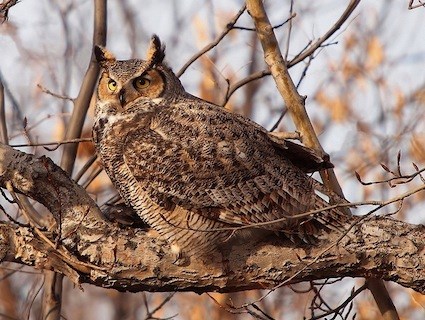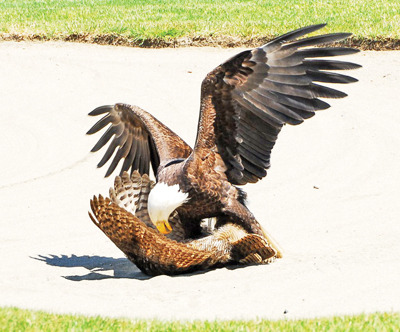Post by Ceratodromeus on Feb 7, 2017 22:57:36 GMT 5

Scientific classification
Kingdom: Animalia
Phylum: Chordata
Subphylum: Vertebrata
Class: Aves
Order: Strigiformes
Family: Strigidae
Genus: Bubo
Species: B.virginianus
Biology
The Great Horned Owl, Bubo virginianus, is a very large owl native to North and South America. It is an adaptable bird with a vast range, though it is not as widespread as the Barn Owl.
Individuals range in length from 45 to 65 cm (18 to 26 inches), has a wingspan of 100 to 150 cm (40 to 60 inches) and weighs from 680 to 2900 grams (1.5 to 6.4 lbs). An average Great Horned Owl is 55 cm (22 inches) long, has a wingspan of 124 cm (49 inches) and weighs about 1400 grams (3.1 lbs). Generally, the largest owls are found closer to the Polar regions and the smallest owls are found closer to the Equator. Females are larger than males. Adults have large ear tufts, a reddish face, a white patch on the throat and yellow eyes. The ear tufts are not actually ears, but simply tufts of feathers. The underparts are light with brown barring; the upper parts are mottled brown. The legs and feet are covered in feathers up to the talons. There are individual and regional variations in color; birds from the sub-Arctic are a washed-out, light-buff color, while those from Central American can be a dark chocolate brown.

Great Horned Owls are some of the earliest-breeding birds in North America. They breed in late January or early February and are often heard calling to each other in the fall, starting in October. They choose a mate by December and are often heard duetting before this time. For owls found in more tropical climes, the dates of the breeding season are somewhat undefined. They often take over a nest used by some other large bird, sometimes adding feathers to line the nest but usually not much more. Old crow, Common Raven, Red-tailed Hawk and large squirrel nests are often favored in North America. However, they are far from dependent on the old nests of others and may use cavities in trees and snags, cliffs, deserted buildings, and artificial platforms. The breeding habitat of the Great Horned Owl extends almost throughout both North America and South America. The habitats they can take up residence in include deciduous, coniferous, and mixed forests, tropical rainforests, pampas, prairie, mountainous areas, deserts, subarctic tundra, rocky coasts, mangrove swamps, and some urban areas. Though less common in the more extreme areas (i.e. the heart of the deserts, extremely dense rainforests) and missing from the high Artic tundra, they are found in most habitats.
The clutch size is usually 2, with a range in size from 1 to 5 eggs (5 is very rare). The average egg breadth is 46.5 mm (1.8 inches), the average length is 55.2 mm (2.2 inches) and the average weight is 51 grams (1.8 oz). The incubation period ranges from 30 to 37 days, averaging 33 days. Brooding is almost continuous until the offspring are about 2 weeks old, after which it gradually decreases. Young owls move onto nearby branches at 6 weeks and start to fly about a week later. The offspring have still been seen begging for food in late October (5 months after leaving the nest) and most do not separate from their parents until right before they start to reproduce for the next clutch (usually December). Birds may not breed for another year or two, and are often vagrants ("floaters") until they establish their own territories.

All adult Great Horned Owls are permanent residents of their territories. Eggs, nestlings and fledgings may be preyed on by foxes, coyotes, wild or feral cats and racoons and their cousins. There are almost no predators of adults, but they may be killed in confrontations with eagles, Snowy Owls and, mostly, other Great Horned Owls, which may end in the eating of the dead owl.

The birds hunt at night by waiting on a high perch and swooping down on prey. Prey is quite variable, but is predominantly small to medium-sized mammals such as rats, squirrels, mice, rabbits, voles, marmots, skunks, shrews, bats, raccoons, house cats and even porcupines. Locally, hares and rabbits can comprise a great majority of subsistence for Great Horned Owls. Birds comprise the other large portion of Great Horned Owl prey, with birds ranging in size from kinglets to Great Blue Herons being taken. Locally, waterbirds, especially coots and ducks, can be important prey; raptors up to the size of Snowy Owls and Ospreys are sometimes taken. Reptiles, amphibians, fish, crustaceans and even insects are occasional prey. In northern regions, where larger prey that cannot be eaten quickly are most prevalent, they may let uneaten food freeze and then thaw it out later using their own body heat.

They have excellent hearing and exceptional vision in low light. In terms of hearing, they have better depth perception than do humans. This is possible because owl ears are not placed in the same position on either side of their head: the right ear is typically set higher in the skull and at a slightly different angle. By tilting or turning its head until the sound is the same in each ear, an owl can pinpoint both the direction and the distance to the source of a sound. The eyes of Great Horned Owls are also nearly as large as those of humans. They are in, fact, so large that they are immobile within their sockets. This is one reason that owls need flexible necks; many can move their heads 270 degrees (not all the way around!).
Their call is a low-pitched but loud "ho-ho-hoo hoo hoo." Sometimes it is only four syllables instead of five. The female's call is higher and rises in pitch at the end of the call. Young owls make hissing or screeching sounds that are often confused with the calls of Barn Owls.
The Great Horned Owl is the provincial bird of Alberta. Great Horned Owls can be easily confused with Bubo magellanicus, the Magellanic Horned Owl (which was for some time believed to belong in this species), and other eagle-owls.
Originally posted by
animaliaenthusiasts.proboards.com/user/11


